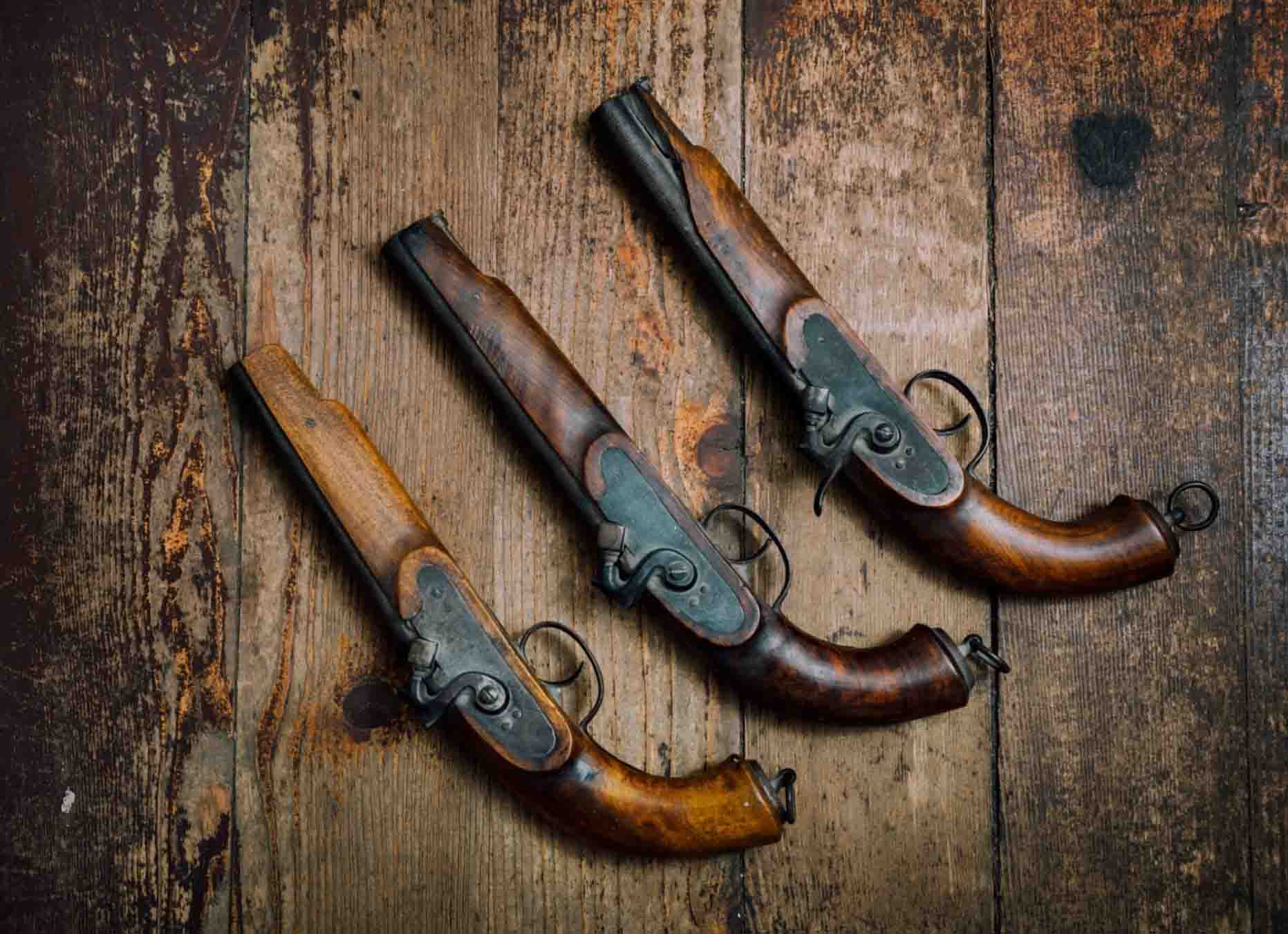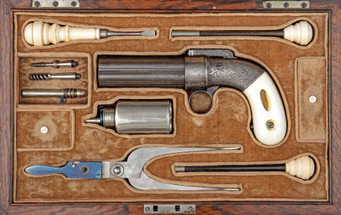Jun 26th 2024
The History and Evolution of Gun Building
The History and Evolution of Gun Building
Gun building has a long, intricate history, blending art and science in a journey that reflects human ingenuity and technological progress. Understanding this history is crucial for appreciating the advancements and innovations that have shaped modern firearms. From early rudimentary devices to sophisticated weapons, the evolution of gun building showcases the constant drive for improvement and efficiency in weaponry.
Early History of Gun Building
Gunpowder, originating in China, laid the groundwork for the development of firearms. Early devices like hand cannons emerged in the 9th century, serving as the ancestors of modern guns. By the 15th century, Europe saw the rise of arquebuses, matchlock firearms that played a pivotal role in warfare by replacing bows and crossbows in many armies. The Renaissance marked a time of rapid gun-building advancements, with innovations in metallurgy improving barrel strength and setting the stage for more sophisticated firearms.
Gun Advancements in the 17th and 18th Centuries
The introduction of flintlock mechanisms revolutionized gun design by offering more excellent reliability and ease of use, dominating firearms technology for over two centuries. This era also saw the emergence of standardization and mass production techniques, ensuring consistency and interchangeability of parts. Firearms became integral to modern warfare, with muskets becoming standard military equipment and playing decisive roles in numerous historical battles.
19th Century Gun Innovations
Percussion cap ignition systems marked a significant advancement in firearm technology, replacing flintlocks and providing more excellent reliability. This period also saw the introduction of rifling, with grooves inside the barrel significantly improving accuracy and making firearms more effective at longer ranges. The development of repeating firearms and revolvers, such as Samuel Colt's influential revolver, allowed multiple rounds to be fired without reloading, further enhancing firepower and efficiency.
Early 20th Century Firearm Developments
The early 1900s witnessed the rise of semi-automatic firearms, which automatically reloaded after each shot, representing a significant leap in firepower. Replacing black powder with smokeless power and other advances in ammunition technology resulted in cleaner and more powerful rounds. The demands of world wars accelerated gun design innovation, creating iconic weapons like the M1 Garand, which provided reliable and high-capacity firepower.
Modern Gun Building Techniques
Modern gun-building techniques incorporate advanced materials like polymers and alloys, reducing weight and improving durability. CNC machining ensures precision and consistency in firearm production. Electronic components, such as red dot sights and laser targeting systems, are increasingly integrated into firearms, enhancing shooting accuracy and convenience. Additionally, modern firearms emphasize customization, with modular designs allowing for easy modifications to cater to military and civilian users.
Current Trends and Future Directions
The advent of 3D printing is revolutionizing gun building by allowing for rapid prototyping and customization, though it also raises regulatory and ethical concerns. Smart gun technology is rising, incorporating biometric security features to enhance safety and prevent unauthorized use. The future of gun building is closely tied to digital advancements, with the integration of AI and intelligent technologies expected to transform the functionality and regulation of firearms.
Gun’s Impact on Society and Culture
Guns hold significant cultural value, symbolizing power, freedom, and heritage, particularly in countries like the United States. Legal and ethical considerations are ever-present, with gun control debates continuing to shape policies and balancing rights and safety remaining a complex challenge. The evolution of gun building reflects broader societal changes, highlighting the ongoing tension between innovation and regulation. This dynamic interplay will continue to influence the future of firearms, as the history and evolution of gun building testify to human ingenuity and the relentless pursuit of technological, cultural, and ethical advancements.

Technological Milestones in Gun Building
Firearms have evolved through technological milestones that have significantly impacted their design, functionality, and use. Early milestones include the development of the matchlock and flintlock mechanisms, which made firearms more reliable and practical. The transition from hand cannons to matchlocks significantly improved usability and accuracy. These early innovations laid the foundation for future advancements in gun building.
19th Century Breakthroughs
The 19th century ushered in significant innovations, such as the percussion cap and rifling, which improved reliability and accuracy. Repeating firearms and revolvers further enhanced firepower and efficiency. The introduction of breech-loading mechanisms allowed for quicker reloading times, and these breakthroughs revolutionized both military tactics and civilian firearm use.
20th Century and Beyond
The 20th century saw the advent of semi-automatic and automatic firearms and advances in ammunition technology. These milestones have had a lasting impact on firearm design and use. Innovations such as developing assault rifles and machine guns transformed modern warfare, and continuous improvement in materials and manufacturing techniques further refined firearm performance.
Cultural and Historical Impact
Firearms have had a profound impact on cultures around the world, influencing everything from warfare and hunting to personal defense and recreation. In many cultures, guns have come to symbolize power, freedom, and independence. That is particularly evident in the United States, where the right to bear arms is enshrined in the Constitution, and guns are deeply ingrained in the national identity. The symbolic value of firearms often reflects broader societal values and historical experiences.
Influence on Historical Events
The availability and use of firearms have often shaped historical events. Gun technology heavily influenced the colonization of the Americas, the expansion of the American frontier, and the various revolutions and wars of independence worldwide. Firearms have also played a significant role in more recent conflicts, from the World Wars to modern-day insurgencies and counter-insurgencies. The ability to wield advanced weaponry has often determined the outcomes of key battles and power shifts.
Guns in Popular Culture
Guns have also left a lasting imprint on popular culture. They feature prominently in literature, movies, and television shows, often symbolizing heroism, rebellion, or lawlessness. Westerns, spy thrillers, and action movies usually revolve around gun-toting protagonists and their exploits. This cultural portrayal has contributed to the mystique and allure of firearms, further embedding them in the collective consciousness. The depiction of firearms in media influences public perceptions and attitudes toward gun ownership and use.

Legal and Regulatory Evolution
Gun laws have evolved significantly over the centuries, reflecting changing societal attitudes towards firearms. In the early days of gun building, few regulations governed the manufacture, sale, or use of weapons. As the prevalence of firearms increased and their societal impact grew, governments started enacting laws to regulate their spread. These initial regulations served as the foundation for more extensive legal structures.
The Second Amendment and U.S. Gun Laws
In the United States, the Second Amendment to the Constitution, ratified in 1791, enshrined the right to bear arms. However, this right has been subject to various interpretations and restrictions. For example, the National Firearms Act of 1934 imposed strict regulations on certain firearms, such as machine guns and short-barreled shotguns. The Gun Control Act of 1968 introduced further restrictions, including prohibitions on the sale of firearms to specific individuals and requirements for serial numbers on all guns.
Global Approaches to Gun Regulation
Different countries have taken different approaches to gun regulation. In the United Kingdom, for example, gun laws are much stricter than in the United States, with a near-total ban on handguns and strict controls on other types of firearms. In Australia, sweeping gun control measures were introduced following the Port Arthur massacre in 1996, resulting in a significant reduction in gun-related deaths. These international examples highlight the diversity of regulatory approaches and their varying impacts on public safety.
Notable Legal Cases
Notable legal cases have also shaped gun legislation. In the United States, the Supreme Court case District of Columbia v. Heller (2008) affirmed an individual's right to possess firearms for self-defense within the home. This landmark decision has had a profound impact on gun regulation and continues to influence the ongoing debate over gun control. Other significant cases have addressed issues such as background checks, assault weapon bans, and the carrying of firearms in public.
Economic Aspects of Gun Building
The firearms industry has a significant economic impact, contributing to local and global economies. Major companies like Smith & Wesson, Remington, and Glock are well-known for their contributions to gun technology and innovation. These companies invest heavily in research and development to produce firearms that meet the needs of their customers, whether for military, law enforcement, or civilian use. The industry's economic influence extends to various sectors, including manufacturing, retail, and services.
Global Market Dynamics
The global market for firearms and related products is substantial, encompassing everything from hunting rifles and handguns to ammunition and accessories. In addition to manufacturing, the industry includes retail sales, training and education, and maintenance and repair services. The economic impact extends beyond direct sales, as the industry supports numerous jobs and generates tax revenue. International trade in firearms is also significant, with many countries importing and exporting guns and related products.
Exports and International Trade
Firearms are also significant export products for many countries. The United States, for example, is one of the largest exporters of firearms, supplying weapons to allies around the world. This aspect of the industry is subject to international regulations and agreements, such as the Arms Trade Treaty, which aims to prevent the illicit trade in firearms and ensure that legal transfers do not contribute to human rights abuses or armed conflict. The balance between economic interests and ethical considerations is a persistent challenge in the global arms trade.
Ethical Considerations and Debates on Gun Ownership
The ethical implications of gun building and ownership are complex and multifaceted. Different stakeholders, including gun owners, policymakers, and activists, often have conflicting perspectives on these issues. For some, owning firearms is fundamental to personal freedom and self-defense. For others, the proliferation of guns represents a significant public safety concern, contributing to violence and crime. These divergent views create a challenging environment for policy-making and public discourse.
Gun Control Debates
Current debates on gun control and rights are deeply polarized. Advocates for stricter gun control argue that limiting access to firearms can reduce gun violence and save lives. They point to countries with stringent gun laws and lower rates of gun-related deaths as evidence of the effectiveness of such measures. Opponents, however, contend that gun control infringes on individual rights and that responsible gun ownership can deter crime and protect against tyranny. Differing interpretations of statistical data and historical evidence further complicate the debate.
Manufacturer Responsibilities
The ethical debate also extends to the responsibilities of gun manufacturers and sellers. Questions arise about the extent to which these entities should be held accountable for misusing their products. Some argue for greater oversight and accountability, while others believe that the focus should be on the individuals who commit crimes with firearms. The balance between corporate responsibility and personal accountability remains a contentious issue within the broader gun control debate.
Shooting Ranges and Their Role in Gun Evolution
Shooting ranges have played a crucial role in the evolution of gun building by providing controlled environments for testing and refining firearms. These facilities allow manufacturers to evaluate their designs' performance, accuracy, and reliability under various conditions. Additionally, shooting ranges offer invaluable feedback from users, which can inform improvements and innovations in gun technology. They also serve as training grounds for novice and experienced shooters, ensuring that users can safely and effectively handle their firearms. Shooting ranges contribute significantly to firearms' responsible use and continuous advancement by supporting skill development and safety education.
Visit the Gunline Shooting blog for more on guns, training, expert insights, and resources.

